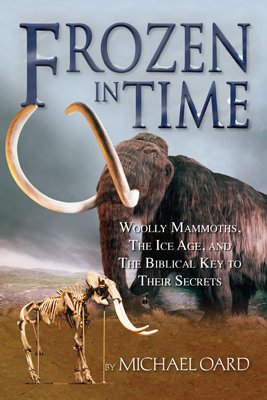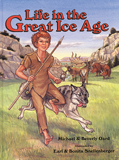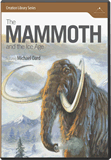
Chapter 4
A Mammoth Number of Mammoth Hypotheses
Efforts to understand the mysteries associated with the woolly mammoth have led to an abundance of hypotheses — all with mammoth problems.
One can imagine that with so many woolly mammoth mysteries, there would be numerous ideas or hypotheses dreamed up over the years. This is indeed the case. Efforts to understand the mysteries associated with the woolly mammoth have led to an abundance of hypotheses — all with mammoth problems. The hypotheses range from native beliefs to astral catastrophes.
Ancient and native beliefs
During the Middle Ages, the local population thought the woolly mammoth remains were prehistoric giants.1 Before the days when geology developed, a famous Russian intellectual insisted the beasts were elephants that died during a vast military campaign led by Chinghiz Kan2 [Genghis Khan]. Then there is the entertaining idea that the bones were from elephants that had run away from Hannibal’s army as the army crossed the Swiss Alps.3
Many natives of Siberia were superstitious and feared the mammoth bones and carcasses, believing that if they viewed a carcass, they would fall ill or die.4 The natives thought the gigantic beasts once lived underground and tunneled forward and backward.5 To explain the remains they found along riverbanks they concluded that when the beast came near the surface to smell the air or see the light it immediately would die. In about 1600, the Chinese emperor K’ang-his (Kangxi) wrote a book on animals in which he supported the Siberian belief that the carcasses were the remains of five-ton rodents who lived beneath the earth’s surface.6 The “freshness” of some meat from the carcasses encouraged their belief that the beasts were still living underground, and that they soon died upon viewing the light.7
Thoughts from early geologists
I believe there is a lot of merit to the ideas of the early geologists. Most of them seemed to provide a straightforward interpretation of the evidence without biases that have crept into modern interpretations, such as the principle of uniformitarianism.
Knowledge of the existence of woolly mammoth fossils filtered into Europe in the 1600s. 8 Trade in mammoth ivory began in the 1700s. Agassiz, Cuvier, Buckland, and most geologists of the time believed the fossils pointed to a once warmer climate in Siberia. 9 Cuvier thought the woolly mammoth became extinct because of abrupt climatic deterioration and were buried by local flooding or other events.10 Following Cuvier with his periodic catastrophic inundations and extinctions, many scientists took the Noachian flood as the last of many catastrophes that wiped out the mammoths.
Charles Lyell at first believed the mammoths lived in southern Siberia and were floated down the rivers to northern Siberia before burial. 11 This idea did not last too long, mostly because the bones showed no indication of having been moved, 12 and many bones are far from rivers. 13 Lyell, the father of the uniformitarian doctrine, ended up grudgingly conceding that the climate must have been a little warmer, but tried to fit the mammoth and the frozen carcasses into his belief of gradual extinctions and faunal replacement. 14 Lyell’s explanation is preferred by most scientists today. 15
Sir Henry Howorth 16 was probably the first to attempt a grand synthesis for the demise of the woolly mammoths in Siberia. He first gathered a massive amount of information on the woolly mammoths, especially in Siberia. He then concluded that a giant flood, likely a shallow Noachian flood that affected only the surface of the earth, swept across all lands of the world, killing the Siberian mammoths. He offered support from the flood traditions of many cultures from around the world. He considered uniformitarianism — “the present is the key to the past” — wholly inadequate to explain the mammoth mysteries. Today, Howorth would be considered a neo-catastrophist, similar to those scientists who believe the dinosaurs died out from a meteorite impact.
Upon rereading Howorth, I was impressed with the substantial amount of data that he had gathered from earlier observations by explorers and travelers. In listing the known Siberian carcasses, Tolmachoff 17 extensively referred to the Howorth collection of data. Howorth’s descriptions of the mammoth distributions and the characteristics of the other fauna, as well as the buried flora, that accompanied the mammoths in Eurasia and North America seem amazingly up to date.
Astral catastrophes and catastrophic crustal shifts
The anomaly of the woolly mammoth carcasses in Siberia has inspired such angst among scientifically minded individuals that several hypotheses of global catastrophism have been invented. I suppose Howorth would be considered the first catastrophist, but the ideas discussed in this section are more modern beliefs. None of these individuals is a Christian, as far as I know.


Immanuel Velikovsky wrote two influential and popular books on astronomical or astral catastrophes called Worlds in Collision 18 and Earth in Upheaval.19 His books sold in the millions. Few remember Velikovsky or his ideas and the considerable consternation he fomented among orthodox scientists. Charles Ginenthal 20 provides an updated, modern defense of Velikovsky’s hypothesis.
According to Velikovsky, astral catastrophes caused great upheavals over the earth. The demise of the woolly mammoths in Siberia played a lead role in his books. He weaves the mysteries of the mammoth, the Ice Age, and many other puzzles from the earth sciences into a catastrophic adventure featuring Venus and Mars moving through the solar system and skimming close by the earth. Then somehow, and despite astronomical odds, these two planets were captured in stable orbits around the sun. He envisioned the astral catastrophes taking place about 3,500 years ago. He believed many of the miracles of the Old Testament, but suggested an astronomical explanation. Velikovsky perceptively points out the multiple problems inherent in explaining the past. Like Howorth, Velikovsky considered the geological doctrine of uniformitarianism inadequate to solve the many mysteries of the past. He cannot help but add an element of exaggeration, as in the following reference to the “muck” of Alaska:
Under what conditions did this great slaughter take place, in which millions upon millions of animals were torn limb from limb and mingled with uprooted trees? 21
Others have also noted the twisted and torn trees with disarticulated mammals in the muck of Alaska. 22 The Alaskan muck, with its mixture of plant and animal remains, is really no mystery substance, as some have suggested. It has a more mundane explanation, which will be discussed later in the book.
Velikovsky and Ginenthal suggest that a sudden shift of the axis of the earth to vertical took place as Mars or Venus passed close to the earth. This caused the Ice Age to end. The warmer Siberian climate attracted migrations of mammoths. Later, about 3,500 years ago, they contend the axis shifted back to the present 23½ degrees, bringing a rapid cooling, and freezing the mammoths in their tracks by a quick freeze. Some died before they could swallow the food in their mouth and before their last meal decayed in their stomachs. With this pole shift, Velikovsky and Ginenthal account for the demise of the mammoths, the cause of the Ice Age, and many other riddles of the recent past.
Velikovsky’s and Ginenthal’s hypothesis has many problems, but one is fatal. A pole shift to a more vertical axis would result in an ice age, not a sudden warming. This may seem strange to many people, because a perpetual spring or fall sounds ideal. However, not many realize an Arctic spring and fall is not warm. The song, “North to Alaska,” does not have a verse about springtime in Alaska being 40 below zero Fahrenheit (-40ºC) for nothing. With the earth’s axis vertical, an endless spring or autumn would cause the snow and ice to build up. The snow and ice would reflect more sunlight back into space, adding to the cooling. The cooling and ice age would slowly spread into the mid latitudes. Even worse for their theory, the snow and ice would accumulate in the lowlands of Siberia and Alaska. These areas we know were never glaciated. These lowlands are the land of the mammoths that inspired Velikovsky’s hypothesis in the first place. The astral catastrophe theory in practice would cause the reverse of what they hoped to explain.
Other popular intellectuals and writers have accepted and embellished on Velikovsky’s ideas. Ivan Sanderson 23 published a short piece in the Saturday Evening Post suggesting a rapid shift of the earth’s crust over the mantle, instead of a shift of the poles. He thinks this caused worldwide volcanism and cooling and a quick freeze of the woolly mammoths.
Charles Hapgood 24 also expounded on Velikovsky’s ideas and agreed with Sanderson that the earth’s crust shifted. He proposed that Siberia moved north and North America south to freeze the mammoths and end the Ice Age. He thought the violent atmospheric disturbances and volcanic cooling, caused by the last displacement of the earth’s crust, specifically killed the Siberian mammoths. His first book was even endorsed in the foreword by Albert Einstein, who seemed to recognize that many climatic mysteries of the past were not being explained well, or even addressed, by mainstream geologists.
I have two problems with Hapgood and several others that postulate such catastrophes — they are not careful with their data and are quick to jump to conclusions. A good example of this occurred when Hapgood 25 stated that Baron Toll, a Siberian explorer, reported a 90-foot (27 m) high fruit tree on the New Siberian Islands. The tree was said to be perfectly preserved in permafrost with its roots intact, and seeds, green leaves, and ripe fruit still clinging to its branches. However, Hapgood does not reference Toll at all, but uses a secondhand report from Bassett Digby, 26 who reported that Toll discovered a 90-foot alder tree on Bol’shoi Lyakhov Island, one of the New Siberian Islands, among the Ice Age animals. The alder (Alnus fructicosa) was intact with roots and seeds. Hapgood obviously embellished the facts.
The quick freeze
In many of the above hypotheses, the mammoths are quick-frozen. This hypothesis is suggested to account for the half-digested state of the stomach contents of several mammoths, the undecayed meat on a few mammoths, and the undecayed nature of many of the bones and tusks. The quick freeze idea actually is an old one, originating from the early 19th century. It probably began with Baron Cuvier and apparently was popular in his time. 27 It is a reasonable suggestion, given the observations. The quick-freeze hypothesis was given a boost by Birds Eye Frozen Foods Company in 1960. Based on heat conduction through beef, they calculated that a sudden plunge to a temperature below -150°F (-100°C) was necessary to account for the state of preservation of the stomach contents of the Beresovka mammoth. 28 Proponents of the quick-freeze idea have great difficulty finding a viable mechanism to account for such a catastrophic cooling. More will be said about this intriguing hypothesis later.
Mainstream scientific hypotheses
Mainstream scientists do not seem to have honestly faced the raw data. They seem to be mentally constrained by their uniformitarian straightjacket, which undergirds their interpretation and conclusions.
William Farrand 29 typifies many scientists’ position on the woolly mammoth’s life and extinction in Siberia. He believes that the climate played little or no role in the demise of the Siberian mammoths because the animals were well adapted to cold. He concludes there is much evidence that ancient Siberia had a similar climate to today, although he admits there is some puzzling data indicative of a little warmer climate. He does not believe there are millions of mammoths entombed in the permafrost and thinks the animals that did live there could have subsisted on the vegetation that grows in Siberia today. Farrand 30 leans strongly toward the uniformitarian view that the woolly mammoth data “… can be adequately explained by the everyday processes which we can observe around us.”
It is questionable whether the woolly mammoth could have adapted to Siberia’s present frigid temperatures or the even colder climate of the Ice Age. The bog vegetation that dominates Siberia’s summers would provide woefully inadequate nutrition for the “well-dressed giants.” Worse, the Siberian summers would melt the permafrost enough to cause the mammoths to mire. Not to be forgotten, it is well substantiated that there were millions of mammoths in Siberia. In conclusion, uniformitarianism does not answer some very essential problems with the existence of millions of apparently well-fed mammoths living in Siberia and becoming extinct within a short time.
Frozen in Time
Author Michael Oard gives plausible explanations of the seemingly unsolvable mysteries about the Ice Age and the woolly mammoths.
Read Online Buy BookFootnotes
- Kurtén, B., How to deep-freeze a mammoth, Columbia University Press, New York, p. 50, 1986.
- Howorth, H.H., The mammoths in Siberia, Geological Magazine 7:550, 1880.
- Tolmachoff, I.P., The carcasses of the mammoth and rhinoceros found in the frozen ground of Siberia, Transactions of the American Philosophical Society 23:viii, 1929.
- Howorth, H.H., The Mammoth and the flood — An attempt to confront the theory of uniformity with the facts of recent geology, Sampson Low, Marston, Searle, & Rivington, London, p. 83, 1887. Reproduced by The Sourcebook Project, Glen Arm, Maryland.
- Ibid., p. 73–74.
- Kiger, P.J., Great mammoth discoveries, Discovery Channel online, 2000.
- Dillow, J.C., The waters above: Earth’s pre-Flood vapor canopy, Moody Press, Chicago, IL, p. 323, 1981.
- Howorth, The Mammoth and the flood, p. 48.
- Grayson, D.K., Nineteenth-century explanations of Pleistocene extinctions: A review; in: Quaternary extinctions: A prehistoric revolution, P.S. Martin and R.G. Klein (Eds.), University of Arizona Press, Tuscon, AZ, p. 11–16, 1984.
- Ibid., p. 9. Berger, W.H., On the extinction of the mammoth: Science and myth; in: Controversies in modern geology — Evolution of geological theories in sedimentology, earth history, and tectonics, D.W. Müller, J.A. McKenzie, and H. Weissert (Eds.), Academic Press, New York, p. 116, 1991.
- Howorth, The Mammoth and the flood, p. 60.
- Tolmachoff, Carcasses, p. ix.
- Howorth, The mammoths in Siberia, p. 551.
- Grayson, Explanations of Pleistocene extinctions, p. 16.
- Hopkins, D.M., J.V. Matthews Jr., C.E. Schweger, and S.B. Young (Eds.), Paleoecology of Beringia, Academic Press, New York, 1982.
- Howorth, H.H., The Mammoth and the flood — An attempt to confront the theory of uniformity with the facts of recent geology, Sampson Low, Marston, Searle, & Rivington, London, 1887. Reproduced by The Sourcebook Project, Glen Arm, Maryland.
- Tolmachoff, Carcasses, p. 11–74.
- Velikovsky, I., Worlds in collision, Pocket Books, New York, 1950.
- Velikovsky, I., Earth in upheaval, Doubleday & Co., New York, 1955.
- Ginenthal, C., The extinction of the mammoth, Ivy Press Books, Forest Hills, NY, 1997.
- Velikovsky, Earth in upheaval, p. 13.
- Hibben, F.C., Evidence of early man in Alaska, American Antiquity 8:256, 1943.
- Sanderson, I.T., Riddle of the frozen giants, The Saturday Evening Post, p. 39, 82, 83, January 16, 1960.
- Hapgood, C.H., Earth’s shifting crust — A key to some basic problems of earth science, Pantheon Books, New York, 1958.
Hapgood, C.H., The path of the pole, Chilton Book Co., New York, 1970. - Hapgood, C.H., Earth’s shifting crust — A key to some basic problems of earth science, Pantheon Books, New York, p. 234–235, 1958.
- Digby, B., The mammoth and mammoth-hunting in north-east Siberia, H.F. & G. Witherby, London, p. 151, 1926.
- Grayson, Explanations of Pleistocene extinctions, p. 5–39.
- Sanderson, Riddle of the Frozen Giants.
- Farrand, W.R., Frozen mammoths and modern geology, Science 133:729–735, 1961. Farrand, W.R., Frozen mammoths, Science 137:450–452, 1962.
- Farrand, W.R., Frozen mammoths, Science 137:450, 1962.
Recommended Resources

Answers in Genesis is an apologetics ministry, dedicated to helping Christians defend their faith and proclaim the good news of Jesus Christ.
- Customer Service 800.778.3390
- © 2024 Answers in Genesis




